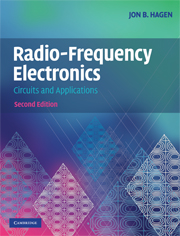Book contents
- Frontmatter
- Contents
- Preface
- 1 Introduction
- 2 Impedance matching
- 3 Linear power amplifiers
- 4 Basic filters
- 5 Frequency converters
- 6 Amplitude and frequency modulation
- 7 Radio receivers
- 8 Suppressed-carrier AM and quadrature AM (QAM)
- 9 Class-C, D, and E Power RF amplifiers
- 10 Transmission lines
- 11 Oscillators
- 12 Phase lock loops and synthesizers
- 13 Coupled-resonator bandpass filters
- 14 Transformers and baluns
- 15 Hybrid couplers
- 16 Waveguide circuits
- 17 Small-signal RF amplifiers
- 18 Demodulators and detectors
- 19 Television systems
- 20 Antennas and radio wave propagation
- 21 Radar
- 22 Digital modulation techniques
- 23 Modulation, noise, and information
- 24 Amplifier and oscillator noise analysis
- 25 The GPS Navigation system
- 26 Radio and radar astronomy
- 27 Radio spectrometry
- 28 S-parameter circuit analysis
- 29 Power supplies
- 30 RF test equipment
- Index
- References
18 - Demodulators and detectors
Published online by Cambridge University Press: 05 June 2012
- Frontmatter
- Contents
- Preface
- 1 Introduction
- 2 Impedance matching
- 3 Linear power amplifiers
- 4 Basic filters
- 5 Frequency converters
- 6 Amplitude and frequency modulation
- 7 Radio receivers
- 8 Suppressed-carrier AM and quadrature AM (QAM)
- 9 Class-C, D, and E Power RF amplifiers
- 10 Transmission lines
- 11 Oscillators
- 12 Phase lock loops and synthesizers
- 13 Coupled-resonator bandpass filters
- 14 Transformers and baluns
- 15 Hybrid couplers
- 16 Waveguide circuits
- 17 Small-signal RF amplifiers
- 18 Demodulators and detectors
- 19 Television systems
- 20 Antennas and radio wave propagation
- 21 Radar
- 22 Digital modulation techniques
- 23 Modulation, noise, and information
- 24 Amplifier and oscillator noise analysis
- 25 The GPS Navigation system
- 26 Radio and radar astronomy
- 27 Radio spectrometry
- 28 S-parameter circuit analysis
- 29 Power supplies
- 30 RF test equipment
- Index
- References
Summary
In communications equipment, “detection” is synonymous with demodulation, the process of recovering information from the received signal. The term detector is also used for circuits designed to measure power, such as square-law microwave power detectors. In this chapter we discuss various AM, FM, and power detector circuits. The demodulator is the last module in the cascade of circuits that form a receiver and at this stage the frequencies (IF or baseband) are relatively low. For this reason the detector (and, sometimes, the final IF bandpass filter) was the first receiver section to evolve from analog to digital processing, notably in broadcast television receivers. Receivers for ordinary AM and FM have, for the most part, continued to use traditional analog detectors, but receivers for the newer digital radio formats can also use their digital signal processors to demodulate traditional AM and FM broadcasts. Demodulators for OFDM and CDMA digital modulation formats are discussed in Chapter 22.
AM detectors
There are two basic types of AM detector. An envelope detector uses rectification to produce a voltage proportional to the amplitude of the IF voltage. A “product” detector multiplies the IF signal by a reconstituted version of the carrier. This detector is a mixer (see Chapter 5), producing sum and difference frequencies. The sum component is filtered away. The difference frequency component, at f = 0 (baseband), is proportional to the amplitude of the IF voltage.
AM diode detector
The classic diode envelope detector circuit for AM is shown in Figure 18.1.
Information
- Type
- Chapter
- Information
- Radio-Frequency ElectronicsCircuits and Applications, pp. 227 - 241Publisher: Cambridge University PressPrint publication year: 2009
References
Accessibility standard: Unknown
Why this information is here
This section outlines the accessibility features of this content - including support for screen readers, full keyboard navigation and high-contrast display options. This may not be relevant for you.Accessibility Information
- 1
- Cited by
